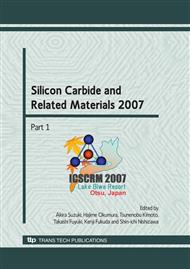p.481
p.485
p.489
p.493
p.497
p.501
p.505
p.509
p.513
Computational Evaluation of Electrical Conductivity on SiC and the Influence of Crystal Defects
Abstract:
The main electronic characteristics of silicon carbide (SiC) are its wide energy gap, high thermal conductivity, and high break down electric field which make of it of one of the most appropriate materials for power electronic devices. Previously we reported on a new electrical conductivity evaluation method for nano-scale complex systems based on our original tight-binding quantum chemical molecular dynamics method. In this work, we report on the application of our methodology to various SiC polytypes. The electrical conductivity obtained for perfect crystal models of 3C-, 6H- and 4H-SiC, were equal to 10-20-10-25 S/cm. For the defect including model an extremely large electrical conductivity (of the order of 102 S/cm) was obtained. Consequently these results lead to the conclusion that the 3C-, 6H-, and 4H-SiC polytypes with perfect crystals have insulator properties while the electrical conductivity of the crystal with defect, increases significantly. This result infers that crystals containing defects easily undergo electric breakdown.
Info:
Periodical:
Pages:
497-500
Citation:
Online since:
September 2008
Price:
Сopyright:
© 2009 Trans Tech Publications Ltd. All Rights Reserved
Share:
Citation:


